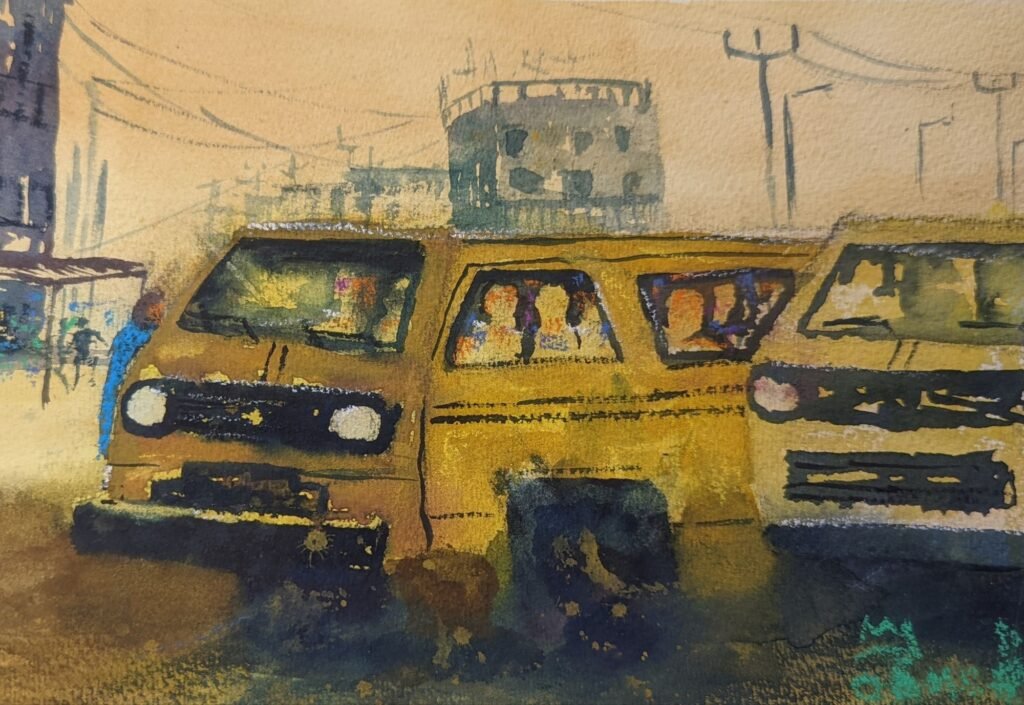
There’s a peculiar rhythm to life in Lagos — a pulse that surges through its streets, propelled by an army of yellow buses known simply as danfos. For most Lagosians, the danfo isn’t just a means of transport. It’s a cultural symbol, a communal space, and often, a theater of everyday drama. Danfo Rush Series 11, part of an ongoing watercolor series, encapsulates this energy with both intimacy and grandeur.
In this work, the artist captures the essence of the Lagos commute. The yellow buses are front and center, hulking yet vibrant, echoing the urgency and disorder that define rush hour. Faces blur behind glass, lines bleed into one another — it’s controlled chaos, just like Lagos itself.
But to fully appreciate the piece, one must understand the context in which the danfo system evolved.
The Backbone of Lagos Mobility
Since the 1970s, danfos have been the lifeblood of Lagos’ public transportation. Typically privately owned and operated, these minibuses filled a crucial gap in the city’s infrastructure. With the rapid growth of Lagos’ population, especially in the late 20th century, the danfo emerged as an affordable, flexible solution. They became a network of their own, connecting neighborhoods and markets, workplaces and schools.
By 1999, when Nigeria returned to democratic rule, Lagos was facing mounting transportation problems: congestion, dilapidated roads, overpopulation, and an unregulated fleet of danfos and molues. The administration of then-Governor Bola Ahmed Tinubu initiated reforms to bring some order to the chaos. While efforts to modernize and centralize transportation services began, including the introduction of the Lagos State Traffic Management Authority (LASTMA), danfos remained firmly entrenched in the city’s transport ecosystem.
From Then to Now
The years since 1999 have seen further attempts by successive governments to revamp the transport system. Initiatives like BRT (Bus Rapid Transit) and, more recently, the Lagos Blue Rail Line, have been launched to offer more structured and efficient alternatives. But even today, danfos continue to dominate, especially in inner-city areas and unstructured routes.
Their endurance is a testament to their adaptability. A danfo driver is part navigator, part negotiator — managing traffic, passengers, law enforcement, and conductors all at once. The buses themselves, often in poor repair, are held together as much by innovation and sheer will as by actual mechanics.
Art as Testimony
Danfo Rush Series 11 isn’t just a painting — it’s a record. It documents a time and place that many city-dwellers know intimately. It’s the noise of the conductor shouting “Ojuelegba! Yaba! CMS!” The heat. The jostle. The exhaustion and relief of finally getting a seat.
What makes this piece powerful is how it merges nostalgia and critique. The painter uses watercolor, a medium known for its fluidity, to express the ever-moving, ever-shifting life of the city. It’s not sanitized. It’s real. And it forces the viewer to consider what’s gained and lost in the rush for modernization.
As Lagos races toward becoming a mega city, the danfo remains both a relic and a necessity. It reminds us of where we’ve come from — and how far we still have to go.
2 Comments
Adewale · June 28, 2025 at 9:53 am
This is super dope 👍
Abdulrahman Aderibigbe · June 28, 2025 at 9:55 am
thank you sir